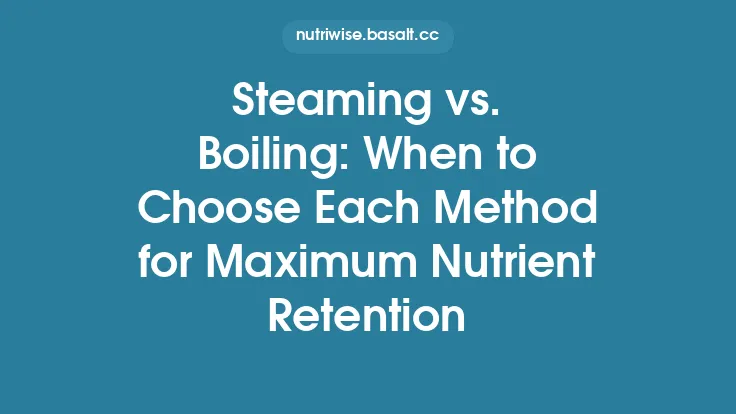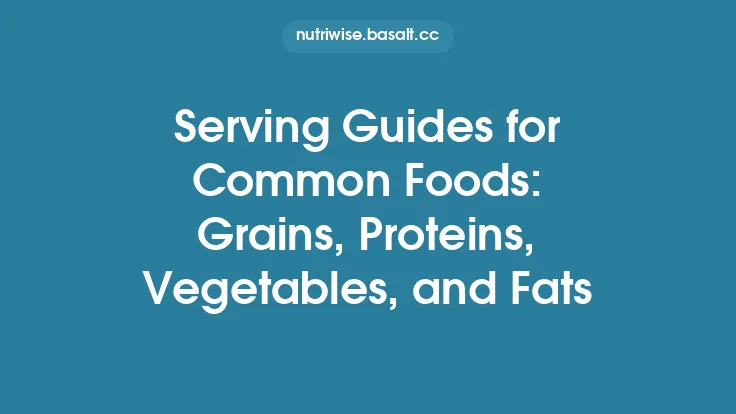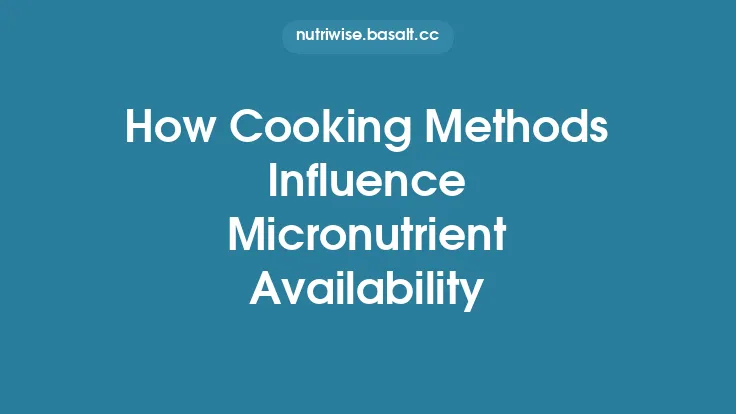Poaching is often overlooked in the pantheon of culinary techniques, yet it stands out as one of the most gentle and nutrient‑preserving ways to cook delicate proteins such as fish, poultry, and shellfish. By immersing the food in a carefully controlled, low‑temperature liquid, poaching minimizes the harsh thermal shock that can denature proteins and leach water‑soluble vitamins and minerals. The result is a tender, moist product that retains its natural flavor, texture, and most of its nutritional bounty. This article delves into the science, technique, and practical applications of poaching, offering a comprehensive guide for anyone who wants to maximize the health benefits of their meals without sacrificing taste.
Understanding Poaching: Principles and Benefits
Definition and Core Concept
Poaching involves cooking food gently in a liquid—commonly water, broth, stock, wine, or a combination—held just below the boiling point (typically 160–185 °F / 71–85 °C). The liquid surrounds the protein, transferring heat evenly and slowly, which prevents the rapid contraction of muscle fibers that can squeeze out juices and nutrients.
Key Benefits for Nutrient Preservation
| Nutrient | Why Poaching Helps Retain It |
|---|---|
| Water‑soluble vitamins (B‑complex, C) | Low temperatures reduce leaching; the brief cooking time limits exposure. |
| Minerals (iron, zinc, selenium) | Minimal water loss means minerals stay within the protein rather than diffusing into the cooking medium. |
| Omega‑3 fatty acids (in fatty fish) | Gentle heat avoids oxidation that occurs at higher temperatures. |
| Protein quality | Slow denaturation preserves essential amino acid structures, improving digestibility. |
Sensory Advantages
Because the cooking medium can be seasoned, poaching imparts subtle flavor without the need for heavy sauces or excessive fats. The gentle heat also yields a uniformly tender texture, ideal for delicate cuts that might otherwise become dry or rubbery.
The Science of Nutrient Retention in Poached Proteins
Thermal Kinetics and Enzyme Inactivation
Proteins begin to denature around 104 °F (40 °C). In poaching, the temperature is kept just high enough to denature surface proteins, creating a protective barrier while keeping the interior relatively untouched. This controlled denaturation reduces the loss of intracellular nutrients that would otherwise escape during more aggressive cooking.
Water‑Soluble Vitamin Stability
Vitamin B1 (thiamine) and B6 (pyridoxine) are particularly heat‑sensitive. Studies show that poaching at ≤185 °F retains up to 90 % of these vitamins, compared with 60–70 % loss in boiling. The limited exposure to water and the short cooking window are the primary reasons.
Lipid Oxidation Prevention
Omega‑3 fatty acids are prone to oxidative degradation at temperatures above 200 °F (93 °C). Poaching’s sub‑boiling environment curtails the formation of free radicals, preserving the health‑promoting EPA and DHA in fish.
Mineral Leaching Dynamics
Minerals are primarily lost through diffusion into the cooking liquid. In poaching, the liquid is often reused as a sauce or broth, meaning the minerals are not discarded but reincorporated into the dish, effectively preserving the mineral content.
Choosing the Right Protein for Poaching
| Protein Type | Ideal Cuts/Portions | Recommended Poaching Time* |
|---|---|---|
| White fish (cod, sole, halibut) | Fillets ½–1 in thick | 4–6 min |
| Fatty fish (salmon, trout) | Fillets ¾–1 in thick | 6–8 min |
| Chicken breast (skinless) | Boneless, pounded to even thickness | 10–12 min |
| Turkey breast (thin slices) | Cut into medallions | 8–10 min |
| Shellfish (shrimp, scallops) | Peeled, deveined | 2–4 min |
| Eggs (for poached eggs) | Fresh, room‑temperature | 3–4 min (water only) |
\*Times are approximate; always verify doneness by internal temperature (145 °F / 63 °C for poultry, 130–135 °F / 54–57 °C for fish) or visual cues (opaque, flake‑test).
Factors to Consider
- Thickness – Thinner pieces cook faster, reducing nutrient exposure.
- Fat Content – Higher fat proteins can tolerate slightly higher temperatures without drying out.
- Freshness – Fresh, high‑quality proteins have more intact nutrients to begin with, making poaching even more advantageous.
Preparing the Poaching Liquid: Flavor and Nutrition
Base Liquids
- Clear Water – Purest method for nutrient retention; add aromatics for flavor.
- Low‑Sodium Broth/Stock – Contributes additional minerals and amino acids without overwhelming the protein.
- Wine or Acidic Additions – A splash of white wine, lemon juice, or vinegar can enhance flavor and aid in gentle protein coagulation, but keep the total acidity below 5 % to avoid toughening the meat.
Aromatics and Herbs
- Onion, Celery, Carrot – Classic mirepoix elements add subtle depth.
- Fresh Herbs (dill, thyme, parsley) – Infuse during poaching; they release volatile oils without requiring high heat.
- Spices (bay leaf, peppercorns) – Provide complexity while remaining heat‑stable.
Nutrient‑Boosting Additions
- Seaweed (kombu) – Adds iodine and trace minerals.
- Mushroom stems – Contribute umami and B‑vitamins.
- Vegetable peels – If using a vegetable‑based broth, retain skins for extra fiber and antioxidants.
Salt Management
Because poaching liquids are often repurposed as sauces, season lightly during cooking and adjust final salt levels at the end. This prevents over‑salting while preserving the natural flavors of the protein.
Temperature Control and Timing
Why Precise Temperature Matters
Poaching is a “low‑and‑slow” technique, but “slow” is relative. The goal is to keep the liquid just below a rolling boil. A gentle simmer (tiny bubbles rising slowly) ensures even heat transfer without the violent agitation that can cause protein fibers to contract sharply.
Practical Methods for Maintaining Temperature
- Thermometer – Use a digital probe to monitor the liquid; set an alarm at 180 °F (82 °C).
- Visual Cue – Small, steady bubbles forming at the bottom of the pot indicate the correct range.
- Stove Settings – Start on medium‑high to bring the liquid to a gentle boil, then reduce to low or medium‑low to maintain the target temperature.
Timing Strategies
- Batch Cooking – If poaching multiple pieces, add them in a single layer to avoid crowding, which can drop the temperature.
- Staggered Entry – For larger cuts, start the thickest pieces first; add thinner ones later to synchronize finish times.
- Rest Period – After removing the protein, let it rest in the poaching liquid (off the heat) for 2–3 minutes. This allows residual heat to finish cooking gently, preserving moisture and nutrients.
Equipment and Tools
| Tool | Recommended Features | How It Enhances Poaching |
|---|---|---|
| Heavy‑Bottomed Pot | 2–3 mm thick base, tight‑fitting lid | Distributes heat evenly, reduces hot spots. |
| Digital Immersion Thermometer | Quick‑read, waterproof probe | Guarantees precise temperature control. |
| Slotted Spoon or Fish Spatula | Thin, flexible blade | Allows gentle removal without tearing delicate flesh. |
| Heat‑Resistant Silicone Basting Brush | Non‑reactive, easy to clean | Useful for basting the protein with infused liquid for added moisture. |
| Vacuum‑Sealed Bag (optional) | Food‑grade, BPA‑free | Enables “poach‑in‑bag” technique for even more controlled heat transfer while retaining all aromatics. |
While a sous‑vide device is a separate method, the vacuum‑sealed bag can be used on the stovetop for a hybrid approach: the bag is placed in the poaching liquid, and the temperature is still monitored directly, preserving the poaching principle of low‑temperature immersion.
Common Mistakes and How to Avoid Them
- Boiling Instead of Simmering
Consequence: Rapid protein contraction, nutrient loss, tough texture.
Solution: Reduce heat as soon as the liquid reaches a full boil; maintain a gentle simmer.
- Over‑Salting the Poaching Liquid
Consequence: Masked natural flavors, increased sodium intake.
Solution: Lightly season; finish with a pinch of salt after cooking if needed.
- Using Too Much Liquid
Consequence: Dilutes flavor and can cause the protein to sit in a stagnant pool, leading to uneven cooking.
Solution: Use just enough liquid to cover the protein by ½–1 inch.
- Neglecting Aromatics
Consequence: Bland final dish, missed opportunity for nutrient enrichment.
Solution: Add a modest bouquet of herbs, vegetables, and spices; keep them fresh for maximum volatile release.
- Skipping Rest Time
Consequence: Moisture may escape when the protein is cut immediately.
Solution: Allow a brief rest in the warm liquid; the gentle residual heat finishes cooking without drying.
- Crowding the Pot
Consequence: Temperature drops, leading to longer cooking times and uneven nutrient retention.
Solution: Poach in batches or use a larger pot to give each piece space.
Health Implications and Dietary Considerations
Low‑Fat, High‑Protein Option
Poaching requires little to no added fat, making it ideal for heart‑healthy diets, weight‑management plans, and low‑calorie meal prep. The protein remains intact, supporting muscle maintenance and satiety.
Allergen Management
Because the cooking medium can be customized, poaching is suitable for individuals with common food allergies. For example, a dairy‑free broth can replace a butter‑rich sauce, and gluten‑free aromatics keep the dish safe for those with celiac disease.
Micronutrient Retention for Specific Populations
- Pregnant Women – Retaining B‑vitamins and iron is crucial; poached fish provides a gentle source of DHA without excessive heat‑induced loss.
- Older Adults – Soft, moist textures aid swallowing (dysphagia) while preserving essential nutrients that might otherwise be lost in tougher cooking methods.
- Athletes – High‑quality protein with preserved omega‑3s supports recovery and inflammation control.
Sodium Control
Since the poaching liquid can be low‑sodium, the final dish can be tailored to meet dietary guidelines for hypertension without sacrificing flavor.
Recipe Applications and Variations
Classic Poached White Fish
- Liquid: 2 cups low‑sodium fish stock, ½ cup white wine, sliced lemon, a few sprigs of dill.
- Method: Bring to a gentle simmer, add 6‑oz cod fillets, poach 5 min, rest 2 min. Serve with a drizzle of the reduced poaching liquid.
Herb‑Infused Poached Chicken Breast
- Liquid: 3 cups chicken broth, crushed garlic, thyme, bay leaf, a splash of apple cider vinegar.
- Method: Simmer, add pounded chicken breasts, poach 10 min, then slice for salads or wraps.
Spicy Poached Shrimp
- Liquid: 2 cups water, ¼ cup soy‑free tamari, sliced ginger, a pinch of red pepper flakes.
- Method: Simmer, add peeled shrimp, poach 3 min, serve over quinoa with a garnish of cilantro.
Poached Egg for Breakfast
- Liquid: Water with a teaspoon of vinegar (helps the whites set).
- Method: Bring to a gentle simmer, create a whirlpool, slide in the egg, poach 3‑4 min, remove with a slotted spoon, and place on whole‑grain toast.
Poached Salmon with Citrus‑Herb Broth
- Liquid: 2 cups water, orange zest, rosemary, a splash of low‑sodium vegetable broth.
- Method: Simmer, add salmon fillet, poach 7 min, finish with a squeeze of fresh orange juice.
Each of these recipes showcases how poaching can be adapted to a wide range of flavor profiles while preserving the nutritional integrity of the protein.
Integrating Poached Proteins into Balanced Meals
- Pair with Whole Grains – Serve poached fish over quinoa, farro, or brown rice to create a complete amino‑acid profile.
- Add Colorful Vegetables – Lightly sautéed or raw vegetables provide fiber and additional phytonutrients; they complement the gentle nature of poached proteins.
- Incorporate Healthy Fats – Drizzle a modest amount of extra‑virgin olive oil or a few toasted nuts for omega‑6/omega‑3 balance without overwhelming the low‑fat poached base.
- Use the Poaching Liquid as a Sauce – Reduce the leftover broth to a glaze, thickening with a small amount of cornstarch or arrowroot if desired, to keep the dish cohesive and nutrient‑dense.
- Mind Portion Sizes – A typical serving of poached protein is 3–4 oz (85–115 g). Complement with ½ cup of grains and 1 cup of vegetables for a balanced plate.
Final Thoughts
Poaching stands out as a timeless, nutrient‑conserving technique that aligns perfectly with modern health‑focused cooking. By mastering temperature control, selecting appropriate liquids, and respecting the delicate nature of proteins, home cooks and professionals alike can deliver meals that are both flavorful and nutritionally robust. Whether you’re preparing a quick weekday dinner, a refined dinner‑party entrée, or a protein‑rich component for a post‑workout meal, poaching offers a reliable, low‑fat, and vitamin‑preserving pathway to culinary success. Embrace the gentle simmer, experiment with aromatic broths, and let the natural qualities of your proteins shine through—your body and palate will thank you.





